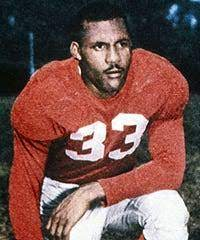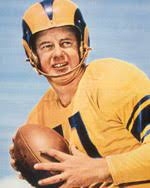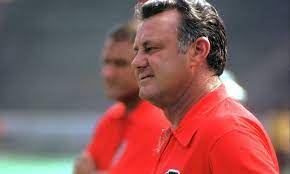Pavlick, Ed (1980). "Pro Football Records Should Include the AAFC" (PDF). The Coffin Corner. 2 (7). Professional Football Researchers Association. Archived from the original (PDF) on March 20, 2023. Retrieved September 12, 2017.
Roberts, Jerry (2015). Pass Receiving in Early Pro Football: A History to the 1960s (illustrated ed.). McFarland. p. 137. ISBN 978-0786499465. Retrieved September 12, 2017.
"Y.A Tittle Bio". Pro Football Hall of Fame. Retrieved August 26, 2016.
"Tiger Den Archives – IX". goldenrankings.com. Archived from the original on March 15, 2016. Retrieved August 15, 2016.
Vincent, Herb (2008). LSU Football Vault: The History of the Fighting Tigers. Whitman Publishing, LLC. p. 57. ISBN 978-0-7948-2428-0.
Finney, Peter (November 18, 2009). "Quarterback Y. A. Tittle made it look easy, even if it wasn't". The Times Picayune. Retrieved August 30, 2016.
Calhoun, Jim (1971). Louisiana Sports Record Book. Pelican Publishing. pp. 25–26. ISBN 978-1-4556-0785-3. Retrieved September 22, 2016.
"Tittle Named Rookie of Year in AAC". Schenectady Gazette. United Press. December 14, 1948. p. 21. Retrieved August 11, 2016.
"Louisiana State Routes Tulane 41-27". The Sunday Morning Star. United Press. December 1, 1946. p. 24. Retrieved August 15, 2016.
"1947 Classic Recap" (PDF). attcottonbowl.com. Archived from the original (PDF) on March 16, 2016. Retrieved May 21, 2016.
Tucker, William (November 21, 1946). "Travis Tidwell, Auburn Back, On 2nd Team". The Anniston Star. p. 16. Retrieved May 30, 2015 – via Newspapers.com. Open access icon
"Three Alabama Players Given Stellar Ratings". The Courier News. November 26, 1947. p. 35. Retrieved August 14, 2016 – via Newspapers.com. Open access icon
"Drop your pants and stumble into Hall of Shame". The Telegraph. Associated Press. May 3, 1987. p. C-12. Retrieved August 24, 2016.
Casstevens, David (January 1, 1987). "Regret? Tittle would change a few things he did". Spokane Chronicle. p. C1. Retrieved August 15, 2016.
"Y. A. Tittle". Louisiana Sports Hall of Fame. Retrieved November 19, 2016.
"1948 NFL Draft Picks". Pro-Football-Reference.com. Sports Reference LLC. Retrieved May 21, 2016.
"Motley Star As Cleve. Browns Down Colts". The Afro American. November 13, 1948. p. 8. Retrieved August 12, 2016.
Coenen, Craig R. (2005). From Sandlots to the Super Bowl: the National Football League, 1920–1967. University of Tennessee Press. p. 170. ISBN 1-57233-447-9. Retrieved August 14, 2016.
Maxymuk, John (2007). Strong Arm Tactics: A History and Statistical Analysis of the Professional Quarterback. McFarland. p. 280. ISBN 978-0-7864-3277-6. Retrieved August 30, 2016.
Sainsbury, Ed (January 19, 1951). "Professional Football Teams Draft College Stars, But Uncle Sam May Come First". The Bulletin. United Press. p. 7. Retrieved August 12, 2016.
"Season Ends In Pro Bowl". Ellensburg Daily Record. Associated Press. January 16, 1964. p. 4. Retrieved August 14, 2016.
"1953 San Francisco 49ers Statistics & Players". Pro-Football-Reference.com. Sports Reference LLC. Retrieved August 14, 2016.
Tameta, Andre (May 22, 2009). "San Francisco's Million Dollar Backfield: The 49ers' Fabulous Foursome". Bleacher Report. Archived from the original on June 9, 2011. Retrieved August 14, 2016.
Fimrite, Ron (September 2, 1996). "49ers Quarterback Y. A. Tittle November 22, 1954". Sports Illustrated. 35 (10). Retrieved August 14, 2016.
"Shoulder Injuries Fell Stars, Reshuffle Pro Grid Standings". Daytona Beach Morning Journal. Associated Press. November 20, 1954. p. 9. Retrieved August 14, 2016.
"West Defeats East 26–19 In All-Star Bowl". Gettysburg Times. Associated Press. January 17, 1955. p. 5. Retrieved August 15, 2016.
Worden, William L. (November 22, 1954). "Tittle of the 49ers". Sports Illustrated. 1 (15): 34. Archived from the original on April 17, 2012. Retrieved August 14, 2016.
Lukas, Paul. "The rich history of helmets". ESPN. Retrieved August 15, 2016.
"Y. A. Tittle – SI Vault". Sports Illustrated. Time Inc. Archived from the original on January 17, 2014. Retrieved August 17, 2016.
"Frankie Albert Appointed San Francisco Head Coach". Toledo Blade. Associated Press. January 13, 1956. p. 28. Retrieved August 16, 2016.
"1956 San Francisco 49ers Statistics & Players". Pro-Football-Reference.com. Sports Reference LLC. Retrieved August 16, 2016.
"alley-oop, adv., int., adj., and n." Oxford English Dictionary. Archived from the original on April 20, 2012. Retrieved August 15, 2016.
Martin, Douglas (June 19, 2012). "R. C. Owens, Receiver Who Made the Alley-Oop Famous, Dies at 77". The New York Times. Retrieved August 14, 2016.
Stevenson, Jack (December 23, 1957). "Another Amazing Comeback Gives Lions 31–27 Victory". Ludington Daily News. Associated Press. p. 10. Retrieved August 16, 2016.
"Tittle, Francis Feted at Million Dollar Dinner". The Bulletin. United Press. January 29, 1958. p. 3. Retrieved August 15, 2016.
"UPI NFL Most Valuable Player Winners". Pro-Football-Reference.com. Sports Reference LLC. Retrieved May 23, 2016.
"1957 NFL All-Pros". Pro-Football-Reference.com. Sports Reference LLC. Retrieved August 16, 2016.
"West Eleven Favored in Pro Bowl Meet". The Bulletin. United Press. January 11, 1958. p. 3. Retrieved August 16, 2016.
Stevenson, Jack (November 3, 1958). "Tittle Sparks San Francisco Victory". The Lewiston Daily Sun. Associated Press. p. 9. Retrieved August 17, 2016.
"Unitas, Arnett, Flu Whip East Pro Stars". Beaver Valley Times. United Press International. January 18, 1960. p. 12. Retrieved August 17, 2016.
"'Shotgun' inventor Red Hickey dead at 89". The Victoria Advocate. March 31, 2006. p. 3B. Retrieved August 17, 2016.
"Giants get Tittle for Cordileone". Milwaukee Sentinel. UPI. August 16, 1961. p. 2-part 3.[permanent dead link]
Wentworth, Bridget (September 22, 2009). "Tittle didn't want Giants trade". The Star-Ledger. Retrieved August 17, 2016.
"Tittle Retires From Pro Football After 17 Seasons". Lodi News-Sentinel. United Press International. January 23, 1965. p. 7. Retrieved August 25, 2016.
Fraley, Oscar (May 11, 1962). "Today's Sport Parade". Reading Eagle. United Press International. p. 16. Retrieved August 19, 2016.
Daley, Arthur (July 19, 1965). "Elements of Uncertainty". The Telegraph. p. 10. Retrieved August 19, 2016.
Hunt, Jim (October 24, 1964). "Who's the guy with the bald head?". The Montreal Gazette. pp. 14–15. Retrieved August 19, 2016.
Sell, Jack (September 20, 1961). "Giant Wheels Hope to Roll Over Steelers". Pittsburgh Post-Gazette. p. 21. Retrieved August 23, 2016.
"Steelers Lose". Herald-Journal. Associated Press. September 25, 1961. p. 7. Retrieved August 23, 2016.
"Tittle Star Of Giants' Key Win; Colts Victors". The Telegraph. Associated Press. November 27, 1961. p. 10. Retrieved August 23, 2016.
Olderman, Murray (December 27, 1961). "Players Name Tittle Thorpe Trophy Winner". The Telegraph. Newspaper Enterprise Association. p. 12. Retrieved August 23, 2016.
"Newspaper Ent. Assoc. NFL Most Valuable Player Winners". Pro-Football-Reference.com. Sports Reference LLC. Retrieved May 23, 2016.
"'Soldier' Hornung Leads Driving Packers To 37–0 Humiliation of New York Giants". Spokesman-Review. Associated Press. January 1, 1962. p. 14. Retrieved August 22, 2016.
Strickler, George (January 1, 1962). "Green Bay 37, New York 0!". Chicago Tribune. p. 1, part 6. Retrieved August 22, 2016.
"Tittle May Retire". The Fort Scott Tribune. Associated Press. January 31, 1962. p. 7. Retrieved August 23, 2016.
"Tittle's Aerials Rip Skins". The Milwaukee Sentinel. United Press. October 29, 1962. p. 3. Retrieved May 9, 2016.[permanent dead link]
"Seven TD passes in a game". profootballhof.com. Pro Football Hall of Fame. Retrieved July 30, 2016.
Miller, Norman (December 17, 1962). "Hot Giants eye title". The Bulletin. United Press International. p. 2. Retrieved August 23, 2016.
"Tittle Earns More Honors". Schenectady Gazette. Associated Press. December 22, 1962. p. 16. Retrieved August 29, 2016.
"The Sporting News Football Almanac". Sporting News. Archived from the original on July 16, 2009. Retrieved December 4, 2016.
"Jim Taylor Player of Year and Allie Sherman Coach of Year in NFL Voting". The Evening Times. Associated Press. December 13, 1962. p. 14. Retrieved January 31, 2017.
Strickler, George (December 31, 1962). "Packers Keep Title; Beat Giants, 16–7". Chicago Tribune. p. 1, part 3. Retrieved August 23, 2016.
"Giants Rip Steelers 33–17 Behind Tittle". Lodi News-Sentinel. United Press International. December 16, 1963. p. 13. Retrieved May 21, 2016.
"Tittle Is Chosen As Most Valuable In National Loop". Lawrence Journal-World. Associated Press. December 13, 1963. p. 16. Retrieved August 24, 2016.
Strickler, George (December 30, 1963). "Bears the Champions! Win, 14–10". Chicago Tribune. p. 1, section 1.
"New York Giants at Chicago Bears - December 29th, 1963". Pro-Football-Reference.com. Sports Reference LLC. Retrieved August 24, 2016.
"1964 NFL Standings, Team & Offensive Statistics". Pro-Football-Reference.com. Sports Reference LLC. Retrieved May 21, 2016.
"Steelers Smash New York; Tittle Given 'Good Beating'". Eugene Register Guard. Associated Press. September 21, 1964. p. 3B. Retrieved August 25, 2016.
"Tittle Decides To Retire At 39". Gadsden Times. Associated Press. January 23, 1965. p. 7. Retrieved May 21, 2016.
"Y.A. Tittle Stats". Pro-Football-Reference.com. Sports Reference LLC. Retrieved August 26, 2016.
Strickler, George (December 27, 1963). "Profile of a Pro". Chicago Tribune. Retrieved August 17, 2016.
Schmitt, Larry (November 4, 2013). "Y. A. Tittle's Incomparable 1962 and 1963 seasons". Big Blue Interactive. Retrieved August 26, 2016.
Maule, Tex (November 18, 1963). "Y. A. Tittle is the best policy". Sports Illustrated. 19 (21). Retrieved August 26, 2016.
Farmer, Sam (September 12, 2002). "A Crew Cut Above". Los Angeles Times. Retrieved August 26, 2016.
"Y. A. Tittle versus John Unitas". Washington Afro-American. January 28, 1964. p. 13. Retrieved August 24, 2016.
Katzowitz, Josh (October 24, 1014). "A happy birthday to Y. A. Tittle, one of the best middle-aged QBs ever". CBS Sports. Retrieved August 26, 2016.
"Y. A. Tittle Retires, Set Longevity Record". The Morning Record. Associated Press. January 23, 1965. p. 5. Retrieved August 26, 2016.
Rappoport, Ken (December 10, 1984). "Tittle and Blanda give Marino passing marks". Gainesville Sun. Associated Press. Retrieved May 21, 2016.
"Giants Ring of Honor: Y. A. Tittle". New York Giants. Archived from the original on October 12, 2016. Retrieved August 29, 2016.
Wolf, Bob (August 14, 1985). "Tittle never got to the top". The Milwaukee Journal. p. 3.
Wickersham, Seth (July 15, 2014). "Awakening The Giant". ESPN the Magazine. Retrieved May 21, 2016.
"New York Giants". Encyclopædia Britannica. Retrieved August 26, 2016.
"AP NFL Most Valuable Player Winners". Pro-Football-Reference.com. Sports Reference LLC. Retrieved May 23, 2016.
Maule, Tex (November 20, 1961). "The Right to be First". Sports Illustrated. p. 20. Archived from the original on January 16, 2014. Retrieved August 17, 2016.
"An Old Story: The Giants and Tittle". Sports Illustrated. September 7, 1964. p. 48. Archived from the original on January 16, 2014. Retrieved August 17, 2016.
Leifer, Neil. "The NFL's Golden Oldies – Y. A. Tittle 1963 N.Y. Giants, age 37". SI Photos. Archived from the original on July 24, 2010. Retrieved January 15, 2014.
Tittle, Y.A. (August 16, 1965). "A Good Quarterback Has To Be His Own Man". Sports Illustrated: 26. Archived from the original on January 16, 2014. Retrieved August 30, 2016.
Damon, Bruce (2010). The Great Book of San Francisco Bay Area Sports Lists. ReadHowYouWant.com. p. 269. ISBN 978-1-4587-7837-6. Retrieved August 30, 2016.
Stewart, Michael (December 5, 2011). "New York Giants: Five Best And Worst Trades In Franchise History". Football Nation. Archived from the original on September 13, 2016. Retrieved August 30, 2016.
Goldstein, Richard (October 9, 2017). "Y.A. Tittle, Quarterback Who Led Giants to 3 Title Games, Dies at 90". The New York Times. Retrieved October 10, 2017.
Shapiro, Michael (February 2007). "Fallen Giant". Smithsonian Magazine. Retrieved May 21, 2016.
Mannix, Vin (February 18, 1982). "Y. A. Tittle and his statue". Boca Raton News. p. 1D. Retrieved August 26, 2016.
Crowe, Jerry (January 28, 2008). "It turned out to be the biggest snap of his career". Los Angeles Times. Retrieved May 21, 2016.
Thurber, Jon (June 21, 2002). "Morris Berman, 92; Tittle Photo Endures". Los Angeles Times. Retrieved May 21, 2016.
How They Racked Up the Great Tittle. Life. October 2, 1964. Retrieved August 30, 2016.
Emerson, Bo (November 22, 2009). "One moment, two photographs, different tales". The Atlanta Journal-Constitution. Retrieved August 31, 2017.
Utterback, Bill (1989). "Former Steeler Baker Still the Enforcer" (PDF). The Coffin Corner. 11 (1). Professional Football Researchers Association. Retrieved August 31, 2017.
"John H. Baker Jr., 72; Played in N.F.L." The New York Times. Associated Press. November 1, 2007. Retrieved August 31, 2017.
"Y. A. Tittle Helps Election Bid of Foe Who Left Him Bloodied". Los Angeles Times. Associated Press. December 5, 1989. Retrieved August 31, 2017.
"Texas Hall Inducts Eight". The Victoria Advocate. Associated Press. January 25, 1987. p. 3B. Retrieved August 29, 2016.
"Louisiana Honors Go To Y. A. Tittle". Gettysburg Times. Associated Press. February 22, 1972. p. 9. Retrieved August 29, 2016.
Rathet, Mike (July 31, 1971). "Nixon Attends Induction Of Brown, Lombardi, Tittle And Others In Grid Hall Of Fame". Gettysburg Times. Associated Press. p. 9. Retrieved May 21, 2016.
"49ers Announce Edward DeBartolo Sr. 49ers Hall of Fame". San Francisco 49ers. May 12, 2009. Retrieved August 30, 2016.
"New York Giants Retired Jersey Numbers". Big Blue Interactive. Retrieved August 25, 2016.
"New York Giants Ring of Honor". Big Blue Interactive. Retrieved August 29, 2016.
"Y. A. Tittle new QB mentor for NY Giants". Eugene Register-Guard. Associated Press. May 19, 1970. p. 3C. Retrieved August 31, 2016.
"Tittle May Be Ready To Call It Quits". Toledo Blade. Associated Press. December 10, 1964. p. 61. Retrieved August 31, 2016.
Goldstein, Richard (October 9, 2017). "Y.A. Tittle, Quarterback Who Led Giants to 3 Title Games, Dies at 90". The New York Times. Retrieved October 9, 2017.
Ziegel, Vic (December 14, 1995). "Daughter's book was a true labor of love". Star-News. p. 2C. Retrieved August 31, 2016.



















